Seahorse Survey
| Three seahorse species, yellow seahorse (Hippocampus kuda), three-spot seahorse (Hippocampus trimaculatus) and great seahorse (Hippocampus kelloggi), have been recorded in Hong Kong waters. According to data reported in 2000, yellow seahorses were moderately abundant in the coral and adjacent eastern Hong Kong waters down to a depth of 7 metres, with no in-depth research done. The seahorse survey conducted by the Foundation aims to document the number, species diversity, size, sex and distribution of seahorses in shallow coral communities above 7 meters and adjacent areas in Hong Kong. |
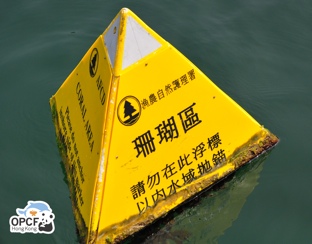 Previous sighting records of seahorses from Hong Kong Reef Check were obtained from Agriculture, Fisheries and Conservation Department (AFCD) and Reef Check Foundation Hong Kong as reference for the site selection. The Foundation’s Senior Scientific Officer will first define survey area for each survey site. The survey team, consists of 4-6 researchers, will then conduct the Global Positioning System (GPS) underwater visual census. Each diver will swim in parallel and search 2m wide habitat for locating seahorses. Previous sighting records of seahorses from Hong Kong Reef Check were obtained from Agriculture, Fisheries and Conservation Department (AFCD) and Reef Check Foundation Hong Kong as reference for the site selection. The Foundation’s Senior Scientific Officer will first define survey area for each survey site. The survey team, consists of 4-6 researchers, will then conduct the Global Positioning System (GPS) underwater visual census. Each diver will swim in parallel and search 2m wide habitat for locating seahorses. |
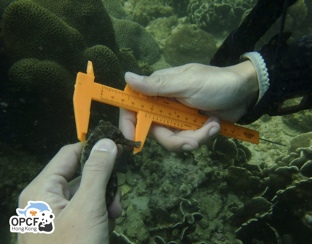 Upon sighting of a seahorse, time and GPS location will be recorded. The body measurements, sex and the substrate to which it was attached will also be recorded. Researchers will take photos for species identification and for record. Upon sighting of a seahorse, time and GPS location will be recorded. The body measurements, sex and the substrate to which it was attached will also be recorded. Researchers will take photos for species identification and for record. |
| The Seahorse Survey and Tagging Project conducted by the Foundation could generate useful data to be shared with the government, other conservation groups and the general public, to help formulate effective conservation management plans. We also recommend the government to document the sites with records of seahorse sightings, such that an ecological survey for the species would be taken into consideration in relation to any future development at those sites. |
| Click to view "Summary of OPCFHK Seahorse Survey Project Report (2011-2012)" |
Seahorse Tagging
| The Foundation showcased its leadership in local seahorse conservation by conducting seahorse survey and embarking on Hong Kong’s first-ever seahorse tagging initiative in 2013, which enables researchers to identify individual seahorses and monitor their long-term survivorship, growth and home range. The ultimate goal is to formulate more effective conservation management plans to protect the local seahorse populations and their habitats. |
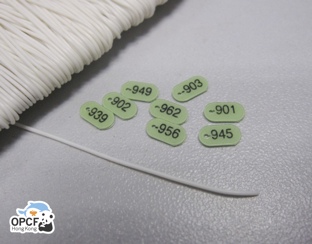 A non-invasive external tagging technique involving collar tags has been chosen, whereby a small green oval PVC disc (3X5mm) with a 3-digit number on one side will be attached to individual seahorse found during the survey (the seahorse has to be over 4cm in length for tagging). A non-invasive external tagging technique involving collar tags has been chosen, whereby a small green oval PVC disc (3X5mm) with a 3-digit number on one side will be attached to individual seahorse found during the survey (the seahorse has to be over 4cm in length for tagging). |
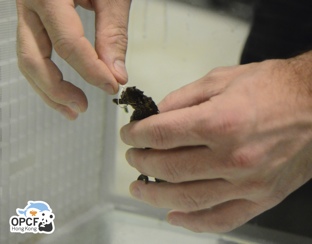 All tags are unique (odd numbers for male; even numbers for female). Researchers will do the tagging underwater after all measurements are done: a tag will be tied using the soft cord to the individual according to the size of its head. The sites with tagged seahorses will be re-visited regularly to search and record for their presence. Tagged seahorses are like carrying an identity card! All tags are unique (odd numbers for male; even numbers for female). Researchers will do the tagging underwater after all measurements are done: a tag will be tied using the soft cord to the individual according to the size of its head. The sites with tagged seahorses will be re-visited regularly to search and record for their presence. Tagged seahorses are like carrying an identity card! |
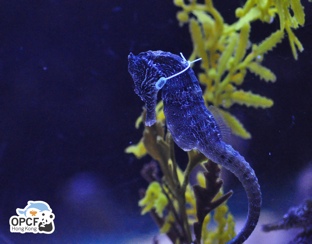 This tagging method has been applied to various seahorse species worldwide, including the U.K., South Africa, Brazil and the Philippines. It was found to be a non-invasive and a successful tagging method by Project Seahorse, (Morgan & Martin-Smith, 2004; Morgan & Bull, 2005), as proven by a study by Seahorse Trust in which a tagged individual was deliberately kept in an obstacle-ridden captive environment for 4 years. Two seahorses have been tagged in Grand Aquarium of Ocean Park as a trial since January 2013; you can go to Ocean Park and visit the tagged seahorses! This tagging method has been applied to various seahorse species worldwide, including the U.K., South Africa, Brazil and the Philippines. It was found to be a non-invasive and a successful tagging method by Project Seahorse, (Morgan & Martin-Smith, 2004; Morgan & Bull, 2005), as proven by a study by Seahorse Trust in which a tagged individual was deliberately kept in an obstacle-ridden captive environment for 4 years. Two seahorses have been tagged in Grand Aquarium of Ocean Park as a trial since January 2013; you can go to Ocean Park and visit the tagged seahorses! |
Seahorse Conservation
| Seahorses are facing different threats, with 11 out of 55 species of seahorse being classified as Vulnerable or Endangered in the IUCN (International Union for Conservation of Nature) Red List of Threatened Species. They are typically threatened by overexploitation for traditional medicinal use, loss or degradation of natural habitats and bycatch in fisheries, causing regional conservation concerns. |
| Take your first step for conserving seahorses by learning more about them: |
 |
Get Involved
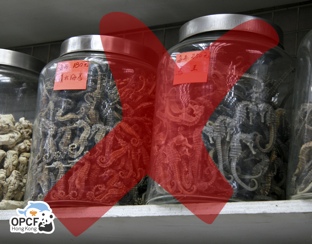
Say No to Seahorse Consumption!
Hong Kong is a major regional hub for the seahorse trade with over 7,000 kg of dried seahorses (about 2.2 million seahorses) imported each year, 80% were imported from Thailand.You, as a responsible consumer, can definitely make a difference by stop consuming dried seahorses. You can also support sustainable seafood to protect more precious marine animals. ACT NOW! Take the pledge! |
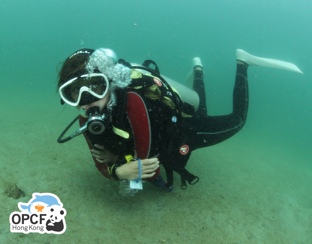
Share Your Sightings!
We invite diving enthusiasts to share with us any seahorse sightings information. If you find a seahorse in Hong Kong waters, please email us with a photo of the sighted seahorse, its size, the location with depth, time and the date of sighting to follow up. If a tagged seahorse is sighted, please share us a photo of the seahorse with the tag number clearly shown. This information helps our seahorse researchers to keep track on the identified seahorse survivorship! |

Join Friends of the Foundation!
Mr. Ekin Cheng, as a conservation advocate and a diving enthusiast, joined our seahorse survey team as "Star Seahorse Researcher". He is also a member of "Friends of the Foundation"!Join and support our conservation efforts through monthly or one-off donation as our new "Friends of the Foundation" member! |
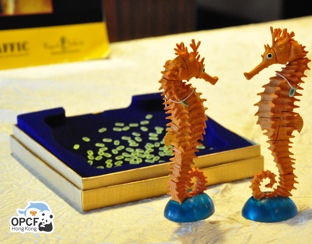
Become a Supporting Organisation
Below organisations and dive clubs have agreed to support and promote the Foundation’s seahorse survey and tagging project:
Contact us if you want to become one of them! |
